This video shows a very simple, yet ingenious way to save the planet from destruction by a giant meteor.
Hiroshima resets “peace clock” after NK nuclear test
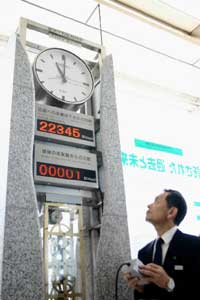 The Hiroshima Peace Memorial Museum's Peace Watch Tower, which records the number of days since the last nuclear test, was reset on October 10, one day after North Korea conducted an underground nuclear test.
The Hiroshima Peace Memorial Museum's Peace Watch Tower, which records the number of days since the last nuclear test, was reset on October 10, one day after North Korea conducted an underground nuclear test.
The peace clock's two digital displays show the number of days since the US atomic bombing of Hiroshima and the number of days since the last nuclear test was conducted. Before being reset on Monday, the clock read 40 -- the number of days since the US conducted a subcritical nuclear test at the end of August.
The clock was set up on August 6, 2001 on the 56th anniversary of the 1945 U.S. atomic bombing of Hiroshima. Over the past 5 years, the clock has been reset 11 times following each of the nuclear tests conducted by the US (some in cooperation with the UK) and Russia.
Museum director Koichiro Maeda says, "We are concerned that more nations will start to believe their national security can be strengthened by possessing nuclear weapons. It is extremely foolish." The museum is now considering making room for North Korea in the reference library exhibit, which displays information about nations possessing nuclear weapons.
About 300 survivors of the Hiroshima nuclear bombing gathered in the park near the museum condemning the possession and testing of all nuclear weapons by all nations.
[Source: Asahi Shimbun, Chunichi]
Jellyfish invasion in full swing
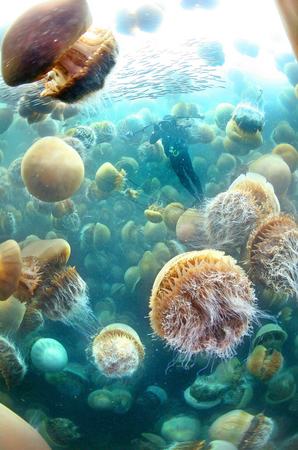 This crazy photo from the Yomiuri Shimbun shows a diver swimming amongst a swarm of giant jellyfish. These giant sea blobs, known as Echizen kurage (Nomura's jellyfish), inflict heavy damage on Japanese fisheries in the Sea of Japan each year.
This crazy photo from the Yomiuri Shimbun shows a diver swimming amongst a swarm of giant jellyfish. These giant sea blobs, known as Echizen kurage (Nomura's jellyfish), inflict heavy damage on Japanese fisheries in the Sea of Japan each year.
This year's invasion appears to be in full swing. The number of jellyfish has risen dramatically off the coast of Maizuru in Kyoto prefecture since Typhoon No. 13 passed over the Sea of Japan in mid-September.
Thousands of the giant jellyfish, which can grow up to 2 meters (6 ft 7 in) in diameter and weigh up to 200 kg (440 lb), become caught in fixed fishing nets each year.
(See also: Chefs prepare for annual giant jellyfish invasion)
[Source: Yomiuri Shimbun]
Actroid DER2 fembot loves Hello Kitty
 Kokoro, a Sanrio Group company specializing in the design and manufacture of robots, unveiled its new Actroid DER2 feminine guide robot at Sanrio headquarters in Tokyo on October 4.
Kokoro, a Sanrio Group company specializing in the design and manufacture of robots, unveiled its new Actroid DER2 feminine guide robot at Sanrio headquarters in Tokyo on October 4.
Actroid DER2 is an upgraded version of Kokoro's previous fembot, Actroid DER, who has made quite a name for herself by providing services at a number of events, including the 2005 World Expo. Compared to the previous model, DER2 has thinner arms and a wider repertoire of expressions. The smoothness of her movement has also been improved, making it now even more likely for the uninitiated to confuse her with an actual human being.
Actroid's limbs, torso and facial expressions are controlled by a system of actuators powered by pneumatic pressure. Once programmed, she is able to choreograph her motions and gestures with her voice.
Kokoro intends to rent Actroid DER2 to companies and events. The basic rental fee is expected to be 400,000 yen (US$3,500) for 5 days, plus extra fees for technical support, delivery and choreography changes. For those who can't cope with a sayonara after 5 days, there is a late fee of 80,000 yen per day.
[Source: Fuji Sankei]
====================
UPDATE - Oct 7, 2006: Video via Robot Watch.
Aimulet LA: award-winning eco design
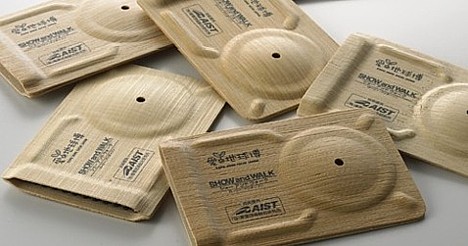
The 2006 Good Design Award for Ecology Design goes to Aimulet LA, a batteryless, light-activated handheld audio communication device with an outer shell made from molded bamboo. The environmentally friendly communication terminal was designed by the Information Technology Research Institute at Japan?s National Institute of Advanced Industrial Science and Technology (AIST).
The name "Aimulet" is derived from the word "amulet" plus the letter "i," which denotes "intelligent," "interactive" and "infrared," as well as "ai" (which means "love" in Japanese and refers to Aichi prefecture, the location of the 2005 World Expo). The initials "LA" stand for none other than Laurie Anderson, whose Walk Project installation for the 2005 World Expo featured the Aimulet LA. Visitors to the installation used the device to receive audio messages as they wandered the site.
Aimulet LA is designed to be held up to your ear like a cellphone. When you stand over special LED emitters set into the ground, Aimulet LA receives the light signals via an array of spherical micro solar cells (called Sphelar by manufacturer Kyosemi) set into the bottom of the handset. Aimulet LA translates the signals into audio messages that are transmitted through a tiny speaker in the device. In Laurie Anderson's installation, visitors used Aimulet LA to listen to poems in four different languages as they strolled through a Japanese-style garden.
According to AIST, the technology at work in Aimulet LA can be put to use in public spaces such as outdoor exhibits and events, amusement facilities, train stations and parks, where it can be used in interactive media or entertainment. In addition, the low cost of the device means it could also double as an entrance ticket, annual pass or ID card.
The Good Design Award judges gave high marks to Aimulet LA's design concept for its ingenious blend of new technology and natural materials. The device also earned points for its lack of external power source, a factor that contributes to the creation of a battery-free environment. Being light-activated also makes it highly versatile, and its use of bamboo makes it easily recyclable and environmentally friendly.
This award marks the first time for AIST to receive a Good Design Award in Ecology Design. AIST previously received a Good Design Award for Paro, the cuddly seal robot recognized by the Guinness Book of World Records as the world's most therapeutic robot.
Check out the Good Design Award page for more amazing designs.
[Source: AIST press release, AIST paper (English, pdf format)]
Space yogurt
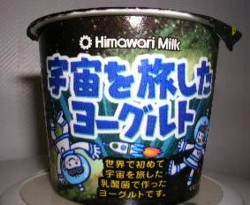 Earlier this month, Himawari Dairy began selling space yogurt, which is made using two types of lactic acid bacteria that spent 10 days in space aboard a Russian Soyuz rocket last spring. The yogurt, called Uchu O Tabi Shita Yogurt (literally: "yogurt that travelled in space"), is now available in Shikoku's four prefectures. The space yogurt follows Tosa Space Sake, which hit shelves last spring, as the second space-related product created to stimulate business in Kochi prefecture.
Earlier this month, Himawari Dairy began selling space yogurt, which is made using two types of lactic acid bacteria that spent 10 days in space aboard a Russian Soyuz rocket last spring. The yogurt, called Uchu O Tabi Shita Yogurt (literally: "yogurt that travelled in space"), is now available in Shikoku's four prefectures. The space yogurt follows Tosa Space Sake, which hit shelves last spring, as the second space-related product created to stimulate business in Kochi prefecture.
Himawari Dairy worked with the Japan Manned Space Systems Corporation (JAMSS) to organize the space trip for the bacteria. The payload included lactic acid bacteria used in ordinary yogurt, as well as a unique strain of Lactobacillus paracasei cultured from pickles preserved in sake lees (sediment that occurs during sake brewing). In previous joint research conducted with Hokkaido University, Himawari found that Lactobacillus paracasei works to enhance the body's immunity to disease. The space yogurt was made using these two types of bacteria mixed with a third type of bacteria.
According to Himawari Dairy President Bunjiro Yoshizawa, about half of the bacteria died in the agar medium due to the harsh environment inside the rocket. The strong, surviving bacteria gives the space yogurt a more full-bodied flavor compared to yogurt made with standard earthbound bacteria.
The space yogurt is priced at 128 yen (a little more than US$1.00) for 90 grams of the pre-sweetened type and 238 yen (about US$2.00) for 400 grams of the plain type. A space yogurt drink is also available in 90 and 500 gram containers.
[Source: Nikkei Net]
Building glows blue with cosmic radiation
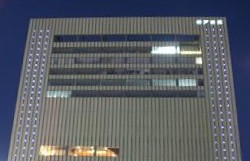 M-INT Kobe, a commercial complex scheduled to open in Kobe on October 4, has been outfitted with an exterior lighting system that translates cosmic energy waves into pulsating blue light. The system is the first of its kind to be installed on a building in Japan.
M-INT Kobe, a commercial complex scheduled to open in Kobe on October 4, has been outfitted with an exterior lighting system that translates cosmic energy waves into pulsating blue light. The system is the first of its kind to be installed on a building in Japan.
Called "Super Nova," the lighting system consists of 2,880 blue LEDs arranged in two columns spanning the height of the 18-story building's west wall. The embedded lights are activated by sensors that detect cosmic rays. According to Takuro Osaka, the University of Tsukuba Graduate School professor who designed the system, the brightness of the blue lights fluctuates according to the intensity of the detected cosmic rays, giving the building an ever-changing magical glow.
Takuro Osaka has been exploring the use of cosmic radiation in art since 1995, and for years he has been discussing the possibility of collaborating with Japan's space agency (JAXA, formerly NASDA) on art projects in outer space. Check out Takuro Osaka's homepage for details about his previous spaced-out projects.
[Sources: Kobe Shimbun, Kobe Topics]
Pre-quake alarm gives 20 seconds to duck and cover
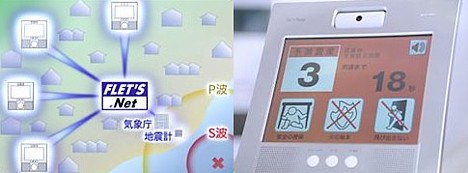
NTT is developing a device that provides advance warning of earthquakes seconds before they strike by relying on data from a nationwide system of seismometers put in place by the Japan Meteorological Agency. The sensors detect an earthquake's primary waves ("P-waves"), which travel more quickly and are much weaker than the lower-velocity secondary waves ("S-waves") that cause the major damage associated with earthquakes.
When the sensors detect P-waves, data about the timing and strength of the coming S-waves is instantly delivered to the earthquake alarms via NTT's fiber optic network, notifying the users in their homes before the S-waves strike. The time difference between the arrival of P-waves and S-waves depends on the distance from the epicenter, so locations farther from the epicenter can receive warnings much more in advance than those near the epicenter. Unfortunately, people located directly above the epicenter, where the earthquake is at its strongest, are unlikely to receive any advance warning at all.
The TV commercial for the device (as well as the extended web version, now on YouTube) shows a mildly touching dramatization of the device at work.
The commercial focuses on a female college student who is majoring in home economics and living at home with her parents. When home alone, the girl spends most of her free time in the kitchen honing her cooking skills by preparing dishes like goya kinoko champuru, an Okinawan stir-fry made with bitter gourd, mushroom and eggs. The kitchen is equipped with an NTT earthquake alarm.
The first time the earthquake alarm sounds, the girl goes into a mild panic, squandering her 20-second warning by wondering where to set the dish she is holding. She finally crawls under the dining table and all is well.
The next time an earthquake comes, she is prepared. The alarm sounds and the mechanical voice informs her that a magnitude 3 earthquake will strike in 20 seconds. As the countdown begins, she calmly turns off the stove, opens the patio doors, and crawls under the table. The voice instructs her to protect herself from physical harm until the shaking stops, advising her not to run outside in a panic. The voice then instructs her to make sure the gas is turned off and evacuate to a safe place once the quake has passed. Finally, the voice instructs her to pay attention to the information provided by the mass media and the local authorities, again reminding her to remain calm.
Later, the girl's mother calls to check on her. Having cooked a great deal of food, the girl tells her mother to come home hungry. Later they will feast.
Luckily for all, the earthquake was only a magnitude 3 affair, unlike the monster that struck Kobe back in 1995.
I have fortunately never seen the need to duck and cover during an earthquake and I don't know how well I would fit under my dining table, but nonetheless it would be nice to have a 20-second warning before the Big One hits.
[Further reading: Asahi Shimbun (English)]
Robot cats seeking new homes
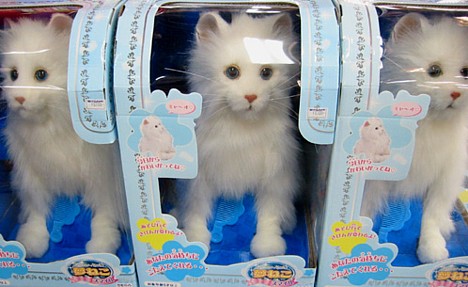
Stacks of boxed feline robots manufactured by Sega Toys, called Yume-Neko Smile ("Dream Cat Smile"), await their fate on the shelves of Tokyo toy shops. While the cats bide their time staring listlessly through the clear plastic windows of their temporary dwellings, Sega Toys steps up its efforts to find homes for them with a new TV commercial.
According to the Yume-Neko Smile homepage, the cuddly robot makes a suitable alternative for anyone unable to keep a real cat. Five sensors at different locations on Yume-Neko's body allow you and the cat to engage in tactile communication. Pet Yume-Neko Smile on the head and it starts purring and flicking its tail around. Stroke its back and it starts to get sleepy. Yume-Neko also likes it when you touch its cheek, and it apparently enjoys being flipped over on its back to have its chest stroked. The cat gets mad when you touch its tail, though, so be careful!
[Link: Yume-Neko Smile homepage]
(See also -- Video: Yume-Neko Smile, Part II)
